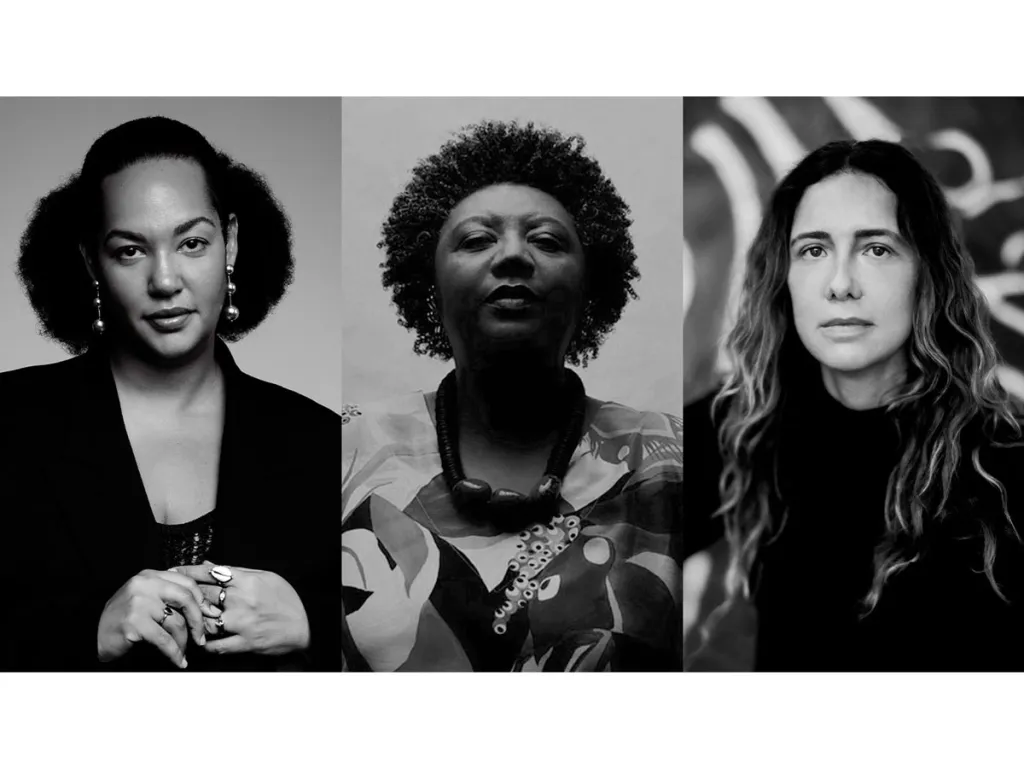Two of Brazil’s leading artists, São Paulo–based Rosana Paulino and Rio de Janeiro–based Adriana Varejão, will represent their country at the next Venice Biennale, which is scheduled to open in May 2026.
Their exhibition will be curated by Diane Lima, an independent curator based in São Paulo and Salvador. Lima most recently cocurated the 2023 Bienal de São Paulo, as well as organizing a survey for Paulo Nazareth at the Museo Tamayo in Mexico City. She received the social justice–focused Ford Foundation Global Fellowship in 2021 and edited the 2024 anthology Negros na Piscina: Arte Contemporânea, Curadoria e Educação (Blacks in
the Pool: Contemporary Art, Curatorship and Education). She also currently serves as deputy chair of the Scientific Advisory Board for Documenta and Museum Fridericianum in Kassel, Germany.
“The curatorship of Diane Lima, with the presence of Rosana Paulino and Adriana Varejão, reaffirms the power and complexity of Brazil’s output on the international stage,” Andrea Pinheiro, the president of the Fundação Bienal de São Paulo, said in a statement.
The upcoming Brazilian Pavilion will take the title of “Comigo ninguém pode,” a popular Brazilian saying that can be translated to “nobody can handle me” or “nobody can beat me”; the phrase also doubles as the Portuguese name for the Dieffenbachia plant, known in English as dumb cane or leopard lily. The pavilion’s title “draws on these ambiguities as a metaphor for protection, toxicity, and resilience,” according to a press release.
Both artists, who are from the same generation, are known for practices that address Brazil’s colonial history, its aftereffects in the present day, and the ways in which these histories can be rewritten and reimagined as a means of liberation.
“Together, Paulino and Varejão historically represent the most revolutionary aspects of the presence of women in the field of national art,” Lima said in a statement. “Their poetics, in harmony and friction, echo the struggles of social movements and democracy, without ever losing the sensitive capacity to amaze and surprise us with high-level technical quality.”
She continued, “Along with the ideas of protection and toxicity, Comigo ninguém pode, as a popular saying, also refers to the process of transferring knowledge about nature to the realm of life, thus reflecting a process of collective manifestation that happens naturally when ‘me’ becomes ‘us,’ becomes many, and an entire nation, which uses its wisdom as a form of defense and sovereignty.”
Paulino, whose practice spans painting, sculpture, drawing, printmaking, collage, and installation, focuses specifically on the experiences of Black women in Brazilian society. On the occasion of winning the $25,000 Munch Award last year, she told ARTnews, “For the last 30 years, I have been focusing on Black females and the Black population in Brazil, and not everyone understands [the challenges we face]. Brazil is often seen as a kind of racial democracy, but it’s absolutely not, so we have to fight.”
She has had solo shows at MALBA in Buenos Aires, the Kunstverein Braunschweig in Germany, and the Museu de Arte do Rio de Janeiro. Her work has featured in major exhibitions like the 2023 Bienal de São Paulo, the 2022 Venice Biennale, and the 2020 Biennale of Syndey, as well as “Project a Black Planet: The Art and Culture of Panafrica” at the Art Institute of Chicago (in 2023), “The Lives of Animals” at the M HKA in Antwerp (2023), and “Histórias Brasileiras” (2022) and “Histórias Afro-Atlânticas” (2018) both at the Museu de Arte de São Paulo. She has received the Order of Cultural Merit from the Brazilian Ministry of Culture and France’s Chevalier des Arts et des Lettres.
“Being in the Brazilian Pavilion in Venice, alongside Adriana Varejão, is an opportunity to investigate colonial wounds from different female perspectives that come together in an unprecedented dialogue,” Paulino said in a statement. “This encounter proposes a revision of art history by questioning the canon and recovering silenced memories, paving the way for new possibilities for the future.”
Since the 1990s, Varejão is best-known for her paintings and scultpures in which viscera are embedded in or appear to spill out of tiled architectural fragments. These blue-and-white tiles, called azulejos and originating in Portugal, draw a connection between Brazil’s past as a Portuguese colony, acting as a metaphor for what lies beneath a seemingly pristine surface.
She has had solo exhibitions at the Pinacoteca do Estado de São Paulo, the Museo Tamayo, the Museu de Arte Modena da Bahia in Salvador, the Institute of Contemporary Art, Boston, and the Museu de Arte Moderna do Rio de Janeiro, among other venues. Her work has featured in the 1998 and 1994 editions of the Bienal de São Paulo, the 2006 and 1999 editions of the Liverpool Biennial, the 2011 Istanbul Biennial, the 2001 Biennale of Sydney, and the 1994 Bienal de Havana.
“Rosana Paulino’s work and mine,” Varejão said in statement, “intersect in the power of colonial wounds, a subject that structures the DNA of our works and runs through our research in a visceral way. I hope to develop a unique dialogue with Rosana that also connects with the architecture of the Pavilion, expanding the possibilities of our artistic paths.”
